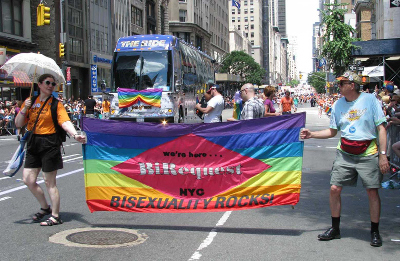
Photo courtesy of Efrain Gonzalez.
Introduction
Everyone is not either gay or straight. This mistaken assumption lies behind most ordinary daily conversations about who and how people create their families, identities, and love lives, but it is often not the whole truth. Bisexual people’s experiences are hidden in plain view, perhaps not visible, sometimes revealed.
This chapter is about that paradox: how we see what has been unseen, become more conscious of those who love others of more than one gender, until we recognize that these relationships and realities are more common than is usually acknowledged and have always been a part of history, visible or not.
If they think about it, most English teachers are aware, for instance, that the writing of Walt Whitman, the well-loved US civil war nurse who changed the form of poetry from rhyming verse to lush free-form praise songs, celebrated the beauty of both women and men in his works, as did poet Edna St. Vincent Millay.[1] Students, however, are rarely taught these parts of their biographies.[2] Read more » [PDF 2.7 MB]
[1] Walt Whitman nursed injured Civil War soldiers at the Old Patent Office Building at F and Seventh Streets NW, Washington, DC. Now home to the National Portrait Gallery, this building was listed on the NRHP on October 15, 1966 and designated an NHL on January 12, 1965. Whitman spent the last years of his life at his home, 330 Dr. Martin Luther King, Jr. Boulevard (formerly Mickle Street), Camden, New Jersey (listed on the NRHP on October 15, 1966; designated an NHL on December 29, 1962). It was here that, just before his death, he finished his final edits to Leaves of Grass. In 1923, Edna St. Vincent Millay was the first woman to win the Pulitzer Prize for poetry. In 1924, she and a group of friends founded the Cherry Lane Theatre, 38 Commerce Street, New York City. While the original group disbanded in 1926, Cherry Lane is the longest continuously-operating off-Broadway theater in New York City, and has a long history of producing LGBTQ-themed plays. Millay’s home, Steepletop, in Austerlitz, New York was listed on the NRHP and designated an NHL on November 11, 1971. She lived in the house from 1925 through 1950.
[2] “The discussion of Whitman’s sexual orientation will probably continue in spite of whatever evidence emerges.” See Jerome Loving, Walt Whitman: The Song of Himself (Berkeley: University of California Press, 1999), 19. Millay had relationships with both women and men. In 1923, she married Eugen Boissevain. Married for twenty-six years, Millay and Boissevain had an open marriage and “acted like two bachelors.” See “Edna St. Vincent Millay,” Academy of American Poets website, https://www.poets.org/poetsorg/poet/edna-st-vincent-millay.
The views and conclusions contained in the essays are those of the authors and should not be interpreted as representing the opinions or policies of the U.S. Government. Mention of trade names or commercial products does not constitute their endorsement by the U.S. Government.
Part of a series of articles titled LGBTQ America: A Theme Study of Lesbian, Gay, Bisexual, Transgender, and Queer History.
Last updated: October 10, 2016
